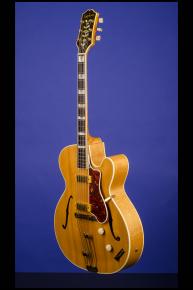The Flagship of the Epiphone Electric Line
1950 Epiphone Zephyr De Luxe Regent
This wonderful full-bodied 17 3/8 inches wide and 3 1/3 inches deep "Jazzbox" weighs just 7.00 lbs. Two-piece laminated spruce top with "Cello" style f-holes, one-piece laminated 'flamed' curly maple back and sides. Five-piece maple, walnut, and mahogany neck with a scale length of 25 1/2 inches, a wide nut width of just under 1 3/4 inches, and a wonderful thick profile rising from 0.90 inches at the nut to 1.04 inches at the ninth fret. Brazilian rosewood fretboard with 20 original medium frets and inlaid pearl block position markers with abalone "V" inserts at frets one, three, five, seven, nine, and twelve, and a pearl block at fret fifteen. Small black side 'dot' markers. The body of the guitar has five-ply binding white and black on the top and back, the neck has four-ply binding of black and white. Headstock with inlaid pearl "Epiphone" script logo and pearl "Vine of Life" inlay, and three-ply binding of white and black. Individual Epiphone closed-back slashed "C" tuners with tulip-shaped Keystone plastic buttons. Adjustable Epiphone "Thrust Rod" with the adjustment at the body end. Two Epiphone "New York" pickups with perfectly balanced outputs of 4.48k and 4.50k. Original tortoiseshell pickguard with three-ply white over black pyralin binding secured to body by a metal bracket and three screws. Two controls (one volume, one tone) and a three-way slide switch for pickup selection, all on lower treble bout. Epiphone white octagonal 'carousel' bakelite knobs with pointers. Rosewood bridge with pre-set compensating saddle and Epiphone 'Frequensator' tailpiece. All hardware gold-plated. Inside the bass f-hole is the 'Epiphone, Inc. New York' rectangular white label with the model name "Zephyr Deluxe Regent" typed in black and the serial number "62803" stamped in black. All hardware gold-plated. This guitar is in exceptionally fine (9.00+) condition with very little signs of wear, just one small scratch on the top (to the left of the three-way switch), a small surface scratch just above the side jack-input, a small area of the typical shrinkage on the celluloid binding on the back in the treble cutaway and two small cracks in the binding on the back. There is also two very slight cracks on the edge of the gold-plated tailpiece (which has never been touched) each measuring no more than 3/8 inch (the full width of the tailpiece is 2 inches). The tailpice is absolutely sound and although easily repairable we would prefer to leave the guitar a s 100% original. This is quite positively one of the best looking and playing examples that we have seen. Housed in its original four-latch, shaped black 'crocodile' hardshell case with purple plush lining (8.75). We have just done a full set-up and intonation. The guitar is now strung with D'Addario Chromes XL Warm/Mellow Tone Flat-Wound 12-52 strings.
The "New York" style pickups which were used between 1946 and 1961 are the most common New York-era Epiphone pickup. They are also considered the "best" top-of-the-line pickup model for pre-1962 Epiphones. They have rectangular metal covers with small slot-screw poles, the poles very close to edge, mounted to top by screws through cream-colored "blocks" or side extensions. Their dimensions are 1 1/8" by 2 13/16" (3 5/8" wide including the mounting blocks).
"Guitarists continued to play Epiphone guitars, and when World War ll ended in 1945, Epiphone renewed its battles with Gibson. One of Gibson's prewar moves had been to introduce 'cutaway' bodies, scooping out the upper treble bout to give the player easier access to the higher frets. Epi caught up after the war, offering the Emperor and De Luxe in cutaway versions in 1948. In the electric arena, Epi jumped a step ahead of Gibson in 1941 with an electric version of a high-end archtop, the Zephyr De Luxe. Shortly after the cutaway version of the De Luxe was introduced, it too was electrified (by 1949). Gibson had been improving the look and sound of its electric line, but it was 1949 before Gibson introduced an electric with the high-end trim of the L-5, called the ES-5 (ES for Electric Spanish), and 1951 before the electric versions of Gibson's L-5 cutaway and Super 400 cutaway appeared. On the marketing side, Epi showed more imagination. The electric cutaway De Luxe had the grandiose name of Zephyr De Luxe Regent. Although the Zephyr has been a separate model, the company appropriated the term 'Zephyr' to mean an electric model. 'Regent' denoted a cutaway. Thus when an electric cutaway version of the Emperor appeared in 1952, it was dubbed the Zephyr Emperor Regent" (Walter Carter, Epiphone: The Complete History, p. 43).
On par with the Gibson L-5CES, the $325.00 (1949 price) flagship of the electric line, the cutaway Zephyr De Luxe Regent was introduced in 1948 with a single pickup mounted between the neck and the bridge.
"The Zephyr De Luxe Regent debuted by 1949 an electric cutaway version of the De Luxe. The top is laminated spruce; the back and sides are laminated maple" (George Gruhn and Walter Carter, Electric Guitars and Basses: A Photographic History, p. 84).
According to Richard Smith (page 240) Epiphone made a run of Zephyr DeLuxe Regents in 1951 within serial numbers between "62796" and "62852". This is one of the earliest of those guitars. We have over the years seen two other examples "62827" and "62842".












